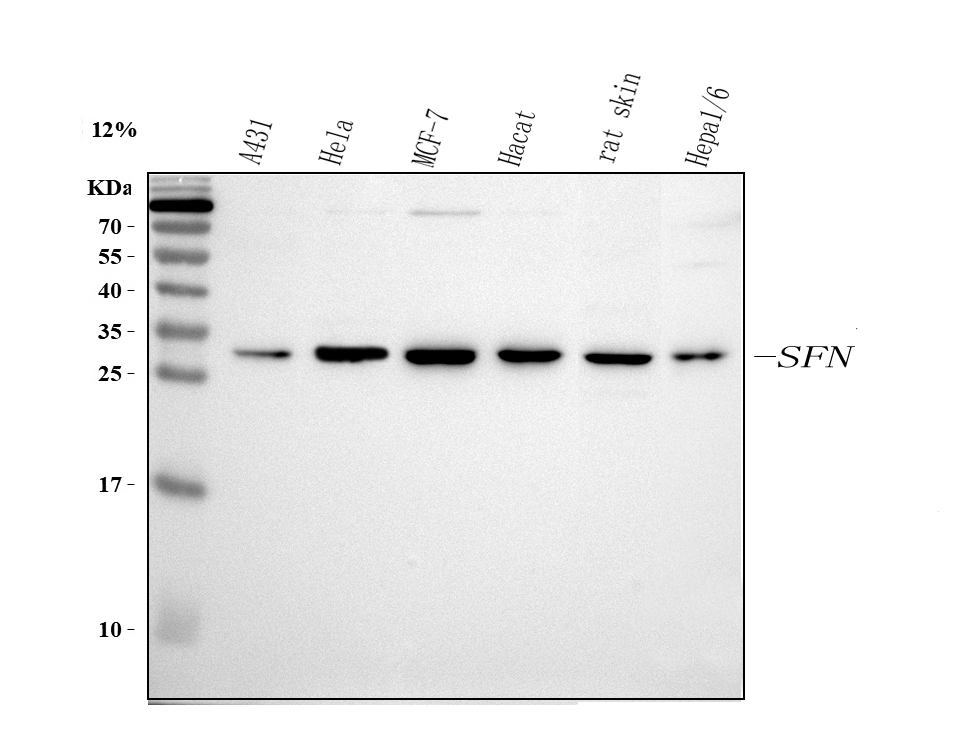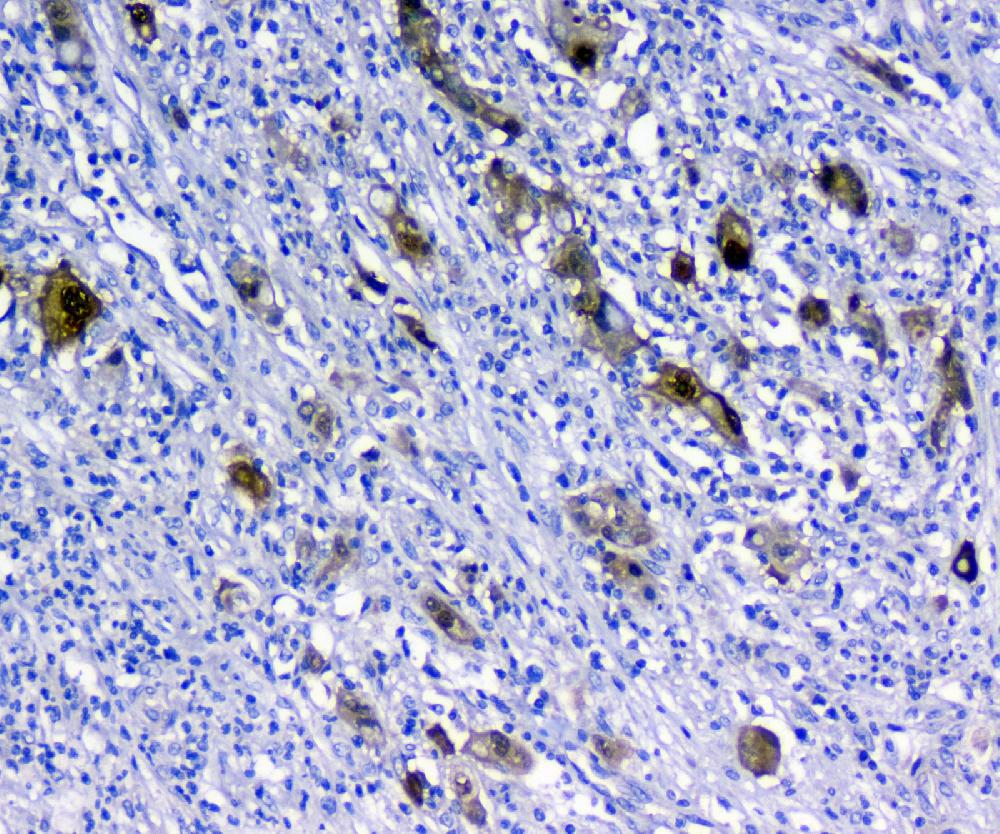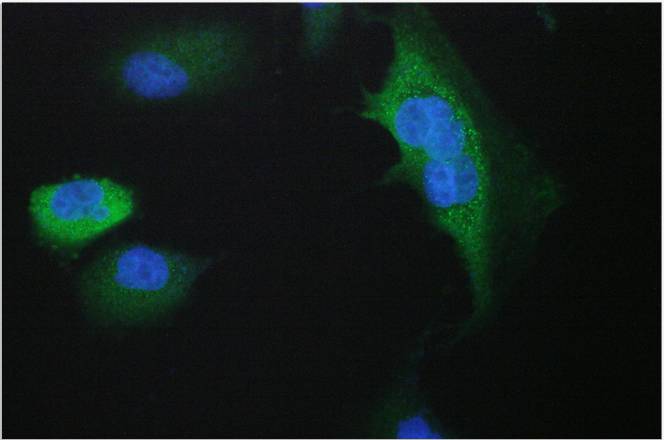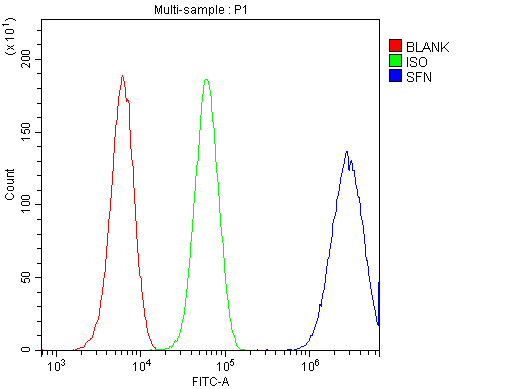| Western blot (WB): | 1:500-2000 |
| Immunohistochemistry (IHC): | 1:50-400 |
| Immunocytochemistry/Immunofluorescence (ICC/IF): | 1:50-400 |
| Flow Cytometry (Fixed): | 1:50-200 |
| Enzyme linked immunosorbent assay (ELISA): | 1:100-1000 |
| (Boiling the paraffin sections in 10mM citrate buffer,pH6.0,or PH8.0 EDTA repair liquid for 20 mins is required for the staining of formalin/paraffin sections.) Optimal working dilutions must be determined by end user. | |

Western blot analysis of anti-14-3-3 Sigma/SFN antibody (A01127). The sample well of each lane was loaded with 30 ug of sample under reducing conditions.
Lane 1: human A431 whole cell lysates,
Lane 2: human Hela whole cell lysates,
Lane 3: human MCF-7 whole cell lysates,
Lane 4: human Hacat whole cell lysates,
Lane 1: rat skin tissue lysates,
Lane 2: mouse Hepa1-6 whole cell lysates.
After electrophoresis, proteins were transferred to a membrane. Then the membrane was incubated with rabbit anti-14-3-3 Sigma/SFN antigen affinity purified polyclonal antibody (A01127) and probed with a goat anti-rabbit IgG-HRP secondary antibody (Catalog # BA1054). The signal is developed using ECL Plus Western Blotting Substrate (Catalog # AR1197). A specific band was detected for 14-3-3 Sigma/SFN at approximately 28 kDa. The expected band size for 14-3-3 Sigma/SFN is at 28 kDa.

IHC analysis of 14-3-3 Sigma/SFN using anti-14-3-3 Sigma/SFN antibody (A01127).
14-3-3 Sigma/SFN was detected in a paraffin-embedded section of human rectal cancer tissue. Biotinylated goat anti-rabbit IgG was used as secondary antibody. The tissue section was incubated with rabbit anti-14-3-3 Sigma/SFN Antibody (A01127) at a dilution of 1:200 and developed using Strepavidin-Biotin-Complex (SABC) (Catalog # SA1022) with DAB (Catalog # AR1027) as the chromogen.

IF analysis of 14-3-3 sigma using anti- 14-3-3 sigma antibody (A01127). 14-3-3 sigma was detected in paraffin-embedded section of A431 cell. Enzyme antigen retrieval was performed using IHC enzyme antigen retrieval reagent (AR0022) The tissue section was blocked with 10% goat serum. The tissue section was then incubated with 2μg/mL rabbit anti- cortactin Antibody (A01127) . DyLight488 Conjugated Goat Anti-Rabbit IgG (BA1127) was used as secondary antibody Visualize using a fluorescence microscope and filter sets appropriate for the label used.

IF analysis of 14-3-3 sigma using anti- 14-3-3 sigma antibody (A01127). 14-3-3 sigma was detected in paraffin-embedded section of A549 cell. Enzyme antigen retrieval was performed using IHC enzyme antigen retrieval reagent (AR0022) The tissue section was blocked with 10% goat serum. The tissue section was then incubated with 2μg/mL rabbit anti- cortactin Antibody (A01127) . DyLight488 Conjugated Goat Anti-Rabbit IgG (BA1127) was used as secondary antibody Visualize using a fluorescence microscope and filter sets appropriate for the label used.

Flow Cytometry analysis of U2OS cells using anti-14-3-3 Sigma/SFN antibody (A01127).
Overlay histogram showing U2OS cells stained with A01127 (Blue line). The cells were blocked with 10% normal goat serum. And then incubated with rabbit anti-14-3-3 Sigma/SFN Antibody (A01127) at 1:100 dilution for 30 min at 20°C. DyLight®488 conjugated goat anti-rabbit IgG (BA1127) was used as secondary antibody at 1:100 dilution for 30 minutes at 20°C. Isotype control antibody (Green line) was rabbit IgG at 1:100 dilution used under the same conditions. Unlabelled sample without incubation with primary antibody and secondary antibody (Red line) was used as a blank control.

Western blot analysis of anti-14-3-3 Sigma/SFN antibody (A01127). The sample well of each lane was loaded with 30 ug of sample under reducing conditions.
Lane 1: human A431 whole cell lysates,
Lane 2: human Hela whole cell lysates,
Lane 3: human MCF-7 whole cell lysates,
Lane 4: human Hacat whole cell lysates,
Lane 1: rat skin tissue lysates,
Lane 2: mouse Hepa1-6 whole cell lysates.
After electrophoresis, proteins were transferred to a membrane. Then the membrane was incubated with rabbit anti-14-3-3 Sigma/SFN antigen affinity purified polyclonal antibody (A01127) and probed with a goat anti-rabbit IgG-HRP secondary antibody (Catalog # BA1054). The signal is developed using ECL Plus Western Blotting Substrate (Catalog # AR1197). A specific band was detected for 14-3-3 Sigma/SFN at approximately 28 kDa. The expected band size for 14-3-3 Sigma/SFN is at 28 kDa.

IHC analysis of 14-3-3 Sigma/SFN using anti-14-3-3 Sigma/SFN antibody (A01127).
14-3-3 Sigma/SFN was detected in a paraffin-embedded section of human rectal cancer tissue. Biotinylated goat anti-rabbit IgG was used as secondary antibody. The tissue section was incubated with rabbit anti-14-3-3 Sigma/SFN Antibody (A01127) at a dilution of 1:200 and developed using Strepavidin-Biotin-Complex (SABC) (Catalog # SA1022) with DAB (Catalog # AR1027) as the chromogen.

IF analysis of 14-3-3 sigma using anti- 14-3-3 sigma antibody (A01127). 14-3-3 sigma was detected in paraffin-embedded section of A431 cell. Enzyme antigen retrieval was performed using IHC enzyme antigen retrieval reagent (AR0022) The tissue section was blocked with 10% goat serum. The tissue section was then incubated with 2μg/mL rabbit anti- cortactin Antibody (A01127) . DyLight488 Conjugated Goat Anti-Rabbit IgG (BA1127) was used as secondary antibody Visualize using a fluorescence microscope and filter sets appropriate for the label used.

IF analysis of 14-3-3 sigma using anti- 14-3-3 sigma antibody (A01127). 14-3-3 sigma was detected in paraffin-embedded section of A549 cell. Enzyme antigen retrieval was performed using IHC enzyme antigen retrieval reagent (AR0022) The tissue section was blocked with 10% goat serum. The tissue section was then incubated with 2μg/mL rabbit anti- cortactin Antibody (A01127) . DyLight488 Conjugated Goat Anti-Rabbit IgG (BA1127) was used as secondary antibody Visualize using a fluorescence microscope and filter sets appropriate for the label used.

Flow Cytometry analysis of U2OS cells using anti-14-3-3 Sigma/SFN antibody (A01127).
Overlay histogram showing U2OS cells stained with A01127 (Blue line). The cells were blocked with 10% normal goat serum. And then incubated with rabbit anti-14-3-3 Sigma/SFN Antibody (A01127) at 1:100 dilution for 30 min at 20°C. DyLight®488 conjugated goat anti-rabbit IgG (BA1127) was used as secondary antibody at 1:100 dilution for 30 minutes at 20°C. Isotype control antibody (Green line) was rabbit IgG at 1:100 dilution used under the same conditions. Unlabelled sample without incubation with primary antibody and secondary antibody (Red line) was used as a blank control.






